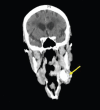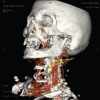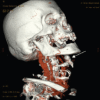Untreated submandibular megalith for over 60 years
- PMID: 29968898
- PMCID: PMC6146257
- DOI: 10.15537/smj.2018.7.22265
Untreated submandibular megalith for over 60 years
Abstract
Intra-parenchymal sialolithiasis and subsequent fibrosis of the submandibular salivary glands is a rare disorder. The resulting swelling, pain, and infection derives affected patients to seek treatment. We present the case of an 85-years-old Saudi male patient who suffered from repeated swelling and infection in the left submandibular region which was misdiagnosed and treated for over 60 years as dental infection, infected skin sebaceous gland or lipoma. The presented case represents the largest intra-glandular submandibular stone with the longest duration ever reported in the medical literature.
Figures







References
-
- Abdullah O, AlQudehy Z. Giant submandibular sialolith: A case report and literature review. Indian Journal of Otology. 2016;22:126–128.
-
- Kim JP, Park JJ, Son HY, Woo SW. An Unusual Case of Bilateral Submandibular Sialolithiasis. Journal of Medical Cases. 2012;3:106–109.
-
- Kamtane S, Ghodke M. Sialolithiasis: An Unusually Large Asymptomatic Submandibular Salivary Stone. Serbian Dental Journal. 2013;60(1)
-
- Zenk J, Koch M, Klintworth N, König B, Konz K, Gillespie MB, et al. Sialendoscopy in the diagnosis and treatment of sialolithiasis: a study on more than 1000 patients. Otolaryngol Head Neck Surg. 2012;147:858–863. - PubMed
Publication types
MeSH terms
LinkOut - more resources
Full Text Sources
Other Literature Sources

